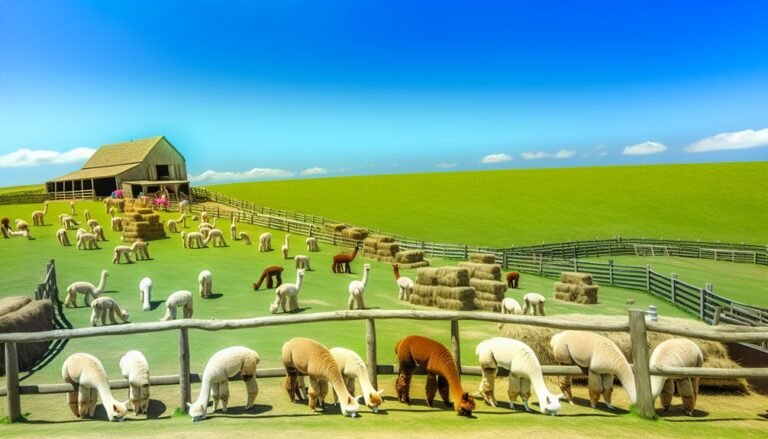What Are the Steps for Processing Alpaca Fiber?
To process alpaca fiber, you’ll first sort and skirt it, removing debris and coarse hairs. Then, carefully wash the fiber in warm water with mild detergent, avoiding agitation to keep fibers intact. After drying gently in the open air, you’ll comb or card the fiber to align strands and remove smaller impurities. This prepares it for spinning into smooth yarn. If you want to know how to fine-tune each step for the best results, keep exploring the details ahead.
Key Takeaways
- Sort and skirt alpaca fiber by color and quality to remove debris, guard hairs, and second cuts for clean batches.
- Wash fiber gently at 130°F with mild detergent, avoiding agitation, and rinse until water is clear to maintain softness.
- Dry fiber outdoors on racks, fluffing regularly to ensure even drying and preserve natural fiber qualities.
- Pick and comb fiber to separate locks, remove coarse hairs, align fibers, and enhance fluffiness for spinning preparation.
- Card fiber multiple times to eliminate impurities, remove neps, blend colors, and produce a soft batt ready for spinning.
Understanding Alpaca Fiber Characteristics

Alpaca fiber stands out for its hollow structure, which helps it retain and release heat better than sheep wool, keeping you warmer. When you examine alpaca fiber, its diameter—measured in microns—plays an essential role in determining quality and softness. The finest alpaca fibers, like Royal and Baby Alpaca, differ by only about 11 microns from coarser grades, highlighting the importance of fiber thickness. You’ll also appreciate alpaca fiber’s strength, which surpasses that of merino wool and cashmere, rated at 50N/ktex. Additionally, the unique overlapping cellular structure of alpaca fiber blocks moisture and bacteria, so garments stay odor-free even after extended wear. Understanding these characteristics helps you value why alpaca fiber is so prized in textile production.
Sorting and Skirting the Fiber
Once the alpaca is sheared, you sort the fiber by color and feel to grade its quality accurately. Skirting comes next, where you remove debris and guard hairs to guarantee a clean batch. These steps are essential because they directly affect the fiber’s value and how it can be used.
Color-Based Sorting
Three key steps define the color-based sorting process: separating the fiber by color, grading its quality, and skirting away impurities. After shearing, you’ll sort alpaca fiber into distinct color bundles, a task requiring trained hands, often Peruvian women with years of expertise. This guarantees consistent color and quality, essential for textile products. Each bundle is then graded using a 6-point scale based on touch and fineness. Proper skirting removes guard hairs and dirt before washing.
When sorting alpaca fiber, focus on:
- Identifying and grouping by natural color shades
- Evaluating fiber softness and fineness carefully
- Removing coarse guard hairs and unwanted fibers
- Preparing the fiber for the next cleaning stage by skirting impurities
Removing Debris
After sorting the fiber by color and quality, the next step is removing debris through sorting and skirting. You’ll spread small batches of about 4 ounces on a screen to pick out dirt, guard hairs, and other unwanted materials. Be sure to identify and remove any second cuts—those short fiber pieces missed during shearing—as they can lower the overall quality. Alpaca fiber usually has more vegetative matter than sheep’s, so this step is essential for cleanliness. Proper skirting reduces the amount of washing needed, making the process more efficient and helping you achieve a cleaner, higher-quality final yarn. Remember to allow for about a 10% waste margin when removing debris to maintain the best fiber for further processing.
Fiber Quality Grading
Although removing debris is essential, the next critical step is grading the alpaca fiber’s quality by touch. Fiber quality grading relies on trained hands evaluating the fineness of the raw fiber rather than microscopes. You’ll find alpaca fiber is sorted on a 6-point scale, with finer fibers like Royal and Baby Alpaca being softer and more valuable. Traditional methods in Peru still bundle fiber by color immediately after shearing. When sorting and skirting the fiber, keep in mind:
- Evaluate fiber diameter to determine softness and application
- Remove guard hairs and impurities through skirting
- Separate fiber by color for consistency
- Recognize that only 11 microns separate the finest grades
This careful grading guarantees the raw fiber meets high standards for various products.
Preparing Fiber for Washing
Before you start washing alpaca fiber, you’ll want to remove any vegetative matter like dust, dirt, and debris, since these can interfere with the cleaning process. Skirting the fiber is a key step here: spread out the fleece on a screen to pick out guard hairs and leftover debris. This makes for a cleaner wash and prevents blockages in your washing machine. Next, divide the fiber into manageable 4-ounce portions, which helps control waste and guarantees even washing. Placing the fiber in zippered mesh laundry bags keeps it contained and protects it from tangling during the wash. Since alpaca fiber lacks lanolin, it’s naturally cleaner than sheep’s wool, but thorough preparation is critical to get the best results before you move on to washing techniques.
Washing Techniques for Alpaca Fleece

When washing alpaca fleece, you’ll want to use a washing machine set to about 130°F with just a small amount of Dawn dish detergent. It’s important to soak the fiber gently without agitation to keep it from felting. After washing, drying the fleece outdoors on hardware cloth while regularly fluffing helps remove any leftover debris and guarantees it dries evenly.
Washing Machine Method
If you want to wash alpaca fiber in a machine, set the water temperature to 130°F and add a small amount of Dawn dish detergent to break down dirt and oils effectively. Using the washing machine method for Alpaca Fleece helps guarantee thorough cleaning without felting. Follow these steps carefully:
- Soak the fiber for about 20 minutes without agitation to avoid matting.
- Drain and spin out water without adding rinse water.
- Repeat washing with minimal detergent until water runs clear.
- Rinse thoroughly with hot water until no dirt remains in the rinse water.
After washing, dry the fiber outdoors on hardware cloth, fluffing and turning it to remove any lingering vegetative matter. This method keeps your Alpaca Fleece clean and soft.
Detergent Use Guidelines
Since alpaca fleece is delicate and prone to felting, you’ll want to use only a small amount of Dawn dish detergent when washing it, as this helps break down oils and dirt without damaging the fibers. To wash the fiber properly, soak it in hot water around 130°F for 20 minutes without agitation, which loosens dirt gently. After soaking, drain and spin the fleece without adding rinse water, repeating the wash with minimal Dawn dish detergent until the water runs clear. During final rinses, use hot water to guarantee no residual dirt remains. Using Dawn dish detergent sparingly guarantees the delicate fibers stay intact, preserving the fleece’s softness and quality throughout the washing process.
Drying and Fluffing
Although washing removes dirt and oils, drying alpaca fiber correctly is just as crucial to preserving its softness and strength. After washing, you’ll want to spread the fiber on racks to dry overnight, steering clear of heaters to avoid overdrying. During drying, fluffing and turning the fiber periodically helps remove any leftover vegetative matter and promotes even moisture loss. Aim for about 20% moisture content before moving on.
Keep these key points in mind during drying and fluffing:
- Spread fiber evenly on racks for natural drying
- Avoid heat sources that can overdry and damage fibers
- Fluff and turn fiber regularly to remove debris and guarantee uniform drying
- Achieve proper moisture level to maintain softness and prepare for carding and spinning
This approach preserves the alpaca fiber’s natural qualities for top-quality yarn.
Drying Methods to Preserve Fiber Quality
When you dry alpaca fiber, you need to be careful not to use heaters, as overdrying can weaken the fibers. The best drying methods involve spreading the washed fiber on racks to air dry overnight. This approach helps maintain the proper moisture content essential for preserving the fiber’s strength and preparing it for the next steps. Before drying, the fiber is thoroughly washed in hot water with biodegradable detergents to remove oils and sweat without using harsh chemicals. Ensuring the fiber retains the right moisture content during drying prevents damage and keeps it fluffy. By carefully managing drying methods, you protect the alpaca fiber’s quality, making sure it stays strong and ready for further processing without compromising its natural softness.
Picking and Opening the Fiber Locks
Now that your alpaca fiber is dried, you’ll want to focus on picking and opening the fiber locks to fluff it up. Using specialized picking techniques helps separate and loosen the fibers, making them easier to work with. Let’s explore the best methods to efficiently open those locks and prepare your fiber for the next step.
Fiber Picking Techniques
Start by feeding the dried alpaca fiber through a picker to open up the locks, which boosts fluffiness and preps the fiber for carding. As the fiber is put through the picker, it helps break down clumps and removes coarse guard hairs, creating a cleaner, finer product. You may need multiple passes to reach ideal fluffiness and adjust moisture to about 20%. During this process, spinning conditioners are added to improve elasticity and cohesion, making spinning easier.
Key points to focus on:
- Confirm fiber is put through evenly to prevent damage
- Remove second cuts and guard hairs effectively
- Adjust moisture content for better processing
- Incorporate spinning conditioners to enhance fiber quality
These techniques lead to a smoother, uniform texture ready for carding.
Opening Locks Methods
Although alpaca fiber arrives in dense locks, you’ll want to open them up using picking methods to boost fluffiness and prepare the fiber for carding. Picking involves feeding dried fiber through a picker, which loosens the locks, adjusts moisture to about 20%, and adds spinning conditioners to improve elasticity and cohesion. This process also removes short second cuts and loose debris, making the fiber cleaner and more uniform. Properly opened locks make carding easier by separating fibers further and eliminating remaining vegetable matter. By opening the locks effectively, you’ll handle the unique challenges alpaca fiber presents, ensuring it’s more manageable and ready for subsequent carding and spinning steps. Picking is essential for achieving a smooth, high-quality fiber preparation.
Combing Alpaca Fiber for Alignment
When you comb alpaca fiber, you use St. Blaise combs to align the fibers and remove shorter strands called second cuts. This step is vital for producing a smooth, continuous strand known as top, similar to the combing process used with Merino wool. To do this effectively:
- Pull the fiber over the comb tines, covering half their height
- Transfer fibers with a second comb, moving away from your body
- Lightly spritz fibers with water to reduce static
- Avoid combing Suri fiber, which is better suited for carding due to its length and fineness
Combing alpaca fiber guarantees uniformity and prepares it well for spinning, giving you a refined, quality yarn ready for the next stage.
Carding Process for Fiber Preparation

After combing your alpaca fiber to align and refine it, the next step is carding, which further prepares the fiber by separating strands and removing any remaining vegetable matter. Using a drum carder, like the Strauch Finest Single Wide, you’ll pass the fiber through the device three times to guarantee ideal separation and quality. This process eliminates coarse guard hairs and second cuts, improving the overall fiber quality. The carder produces a fluffy sheet called a batt, which can be split into slivers, making spinning easier. You can also blend different colors of fiber during carding to create unique nests for varied aesthetics. Passing your fiber through the drum carder three times guarantees it’s perfectly prepared for the next steps in processing.
Removing Vegetative Matter, Seconds, and Neps
Since alpaca fiber naturally lacks lanolin, you’ll find it cleaner than sheep’s wool, but you still need to carefully remove vegetative matter like dust, straw, and dirt to confirm quality. This step is vital to maintain the fiber’s softness and guarantee the final product is free from impurities. You’ll also want to eliminate second cuts—those short fleece pieces missed during shearing—to keep the fiber uniform. Neps, or small tangled knots, should be removed during carding for smoothness.
Alpaca fiber is naturally clean but requires careful removal of dust, second cuts, and neps for softness and quality.
To effectively remove these impurities, focus on:
- Sorting by hand to detect and extract vegetative matter
- Skirting to discard second cuts and coarse fibers
- Thorough cleaning to eliminate dirt and dust
- Carding to remove neps and prepare the fiber for spinning
Blending and Dyeing Alpaca Fiber
Although alpaca fiber is prized for its natural warmth and softness, blending it with other fibers like wool or silk can boost elasticity and add unique textures to your finished product. You can experiment with blending different colors during carding to create striking fiber nests, offering creative freedom in your yarn’s appearance. When it comes to dyeing, pre-wash the fiber to remove oils and dirt for even color results. Alpaca takes well to acid dyes, ideal for protein fibers, and you can choose methods like immersion, hand painting, or kettle dyeing. Keep in mind, alpaca’s natural palette of 22 shades—from white to browns and blacks—provides a beautiful base if you prefer subtle or rustic looks without dyeing.
Frequently Asked Questions
How Is Alpaca Fiber Processed?
You’ll find that alpaca shearing yields about 5-10 pounds of fiber yearly. After fiber grading, you clean, tumble, wash, dry, pick, and card it—transforming raw fleece into soft, spinnable fiber ready for crafting.
What Are the Steps in Processing Wool Fibres?
When processing wool fibers, you start with shearing techniques to guarantee high fiber quality. Then, you skirt, wash, card, spin, and set the yarn, carefully handling each step to preserve the wool’s softness and strength.
How to Process Alpaca Fleece for Beginners?
Imagine you’re new to alpaca care, noticing their fleece’s softness and lack of lanolin. You’ll start by skirting debris, then gently washing and drying the fiber, preparing it carefully to preserve those unique fleece characteristics.
What Is the Process of Alpaca Wool?
You’ll appreciate alpaca characteristics like softness and warmth. Its fiber benefits include hypoallergenic, lightweight, and strong qualities. Processing involves shearing, cleaning, picking, and carding to prepare the fiber for spinning into luxurious yarns.







Our picks
Alpaca & Wool Felted Sole Inserts: Comfy Upgrade?
Best Alpaca Socks for Hiking: Ultimate Comfort and Durability on Trails
Best Alpaca Halter for Comfort and Control